
![Ver [García-Mercadal y García-Loygorri, F.; 2010] en referencias bibliográficas. Libro abierto, hojas de plata, filo de oro, guardas de gules, tapas de sable.](../css/Libro.Bibliografia.png)
García-Mercadal y García-Loygorri, F.; 2010
Fernando García-Mercadal y García-Loygorri, «Penas, Distinciones y Recompensas: Nuevas Reflexiones en torno al Derecho Premial», [Emblemata; 2010; pages 205-235], Volume 16th, Aragonesa de Emblemática Magazine, ERAE, Fernando El Católico Institution, ISSN 1137-1056, Zaragoza, 2010.
Bibliographical reference of century XXI.
Classification: Article.
Author: García-Mercadal y García-Loygorri, Fernando.
External resource:


Peregrina Corona, Dolores
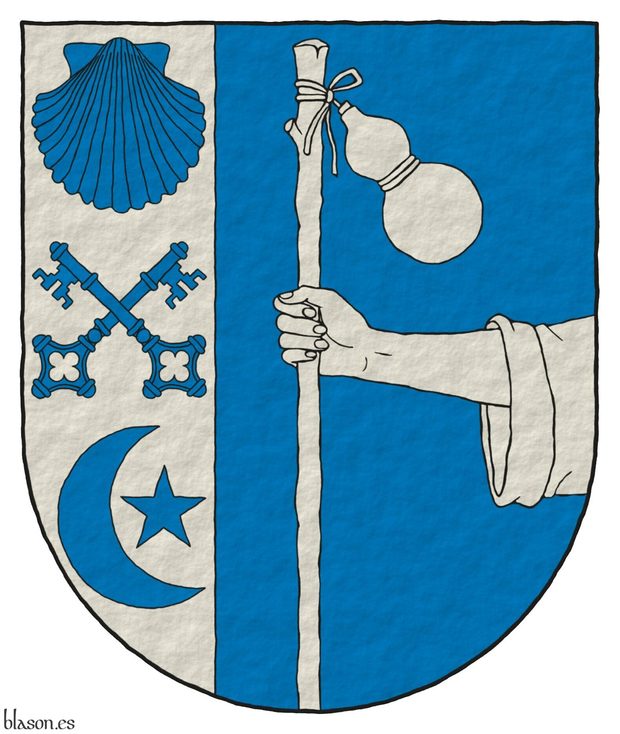
Tierce: 1 Argent, two keys points upwards, in saltire, between in chief an escallop, and in base a mullet of five points environed at dexter by a crescent bendwise azure; 2 Azure, a dexter arm vested, issuant from sinister, grasping a pilgrim's staff palewise, issuant from base, tied to it a gourd bendwise Argent.
Escudo adiestrado: 1o de plata, dos llaves alzadas en sotuer, acompañadas en jefe de una venera, y en punta de una estrella de cinco puntas, circundada a la diestra de un creciente puesto en banda todo de azur; 2o de azur, un brazo diestro vestido, moviente de la siniestra, teniendo un bordón de peregrino puesto en palo, moviente de la punta, y atada a él una calabaza puesta en banda todo de plata.
Arms designed by me, in flat tinctures, contoured in Sable, with a semi-circular outer contour and with a texturized finishing.
Canting arms of Dolores Peregrina Corona designed by Juan Lanzagorta Vallín and me and emblazoned by me. In Castilian heraldic tradition, the «adiestrado» ~ «tierce» used in this coat of arms and its symmetrical «siniestrado» ~ «tierce sinister» are «irregular divisions of the field by one line» ~ «particiones irregulares». That is why I use «tierce» and «tierce sinister» in English. There is another possibility, which is to call the «adiestrado» ~ «pale in dexter flank» and the «siniestrado» ~ «pale in sinister flank», thus ceasing to be a type of «divisions of the field» ~ «particiones» and becoming «ordinaries» ~ «piezas fundamentales». This has implications, as the rule of tinctures would apply if it were considered a «pale» ~ «palo». In any case, I will write the blazon in both ways. Alternative blazon: Azure, a dexter arm vested, issuant from sinister, grasping a pilgrim's staff palewise, issuant from base, tied to it a gourd bendwise; on a pale in dexter flank Argent two keys points upwards, in saltire, between in chief an escallop, and in base a mullet of five points environed at dexter by a crescent bendwise azure.
Design rationale
These are canting arms because her surname is «Peregrina» ~ «pilgrim», and her coat of arms depicts the arm of a pilgrim, as she is one herself, with her staff and her gourd for carrying water, advancing towards the dexter, in order to reach the destination of her three most important life pilgrimages: Santiago de Compostela, Rome, and Jerusalem.
Blazon keywords: Azure, Argent, One, Two, Tierce, Key, Point upwards, In saltire, Between, In chief, Escallop, In base, Mullet, Environed, Dexter, Crescent, Bendwise, Arm, Vested, Issuant from the sinister flank, Grasping, Pilgrim's staff, Palewise, Issuant from base, Tied and Gourd.
Style keywords: Outlined in sable, Plain tincture and Semi-circular.
Classification: Personal, Created, Boa and Coat of arms.
Bearer: Peregrina Corona, Dolores.


María Asunción de León González, outlined
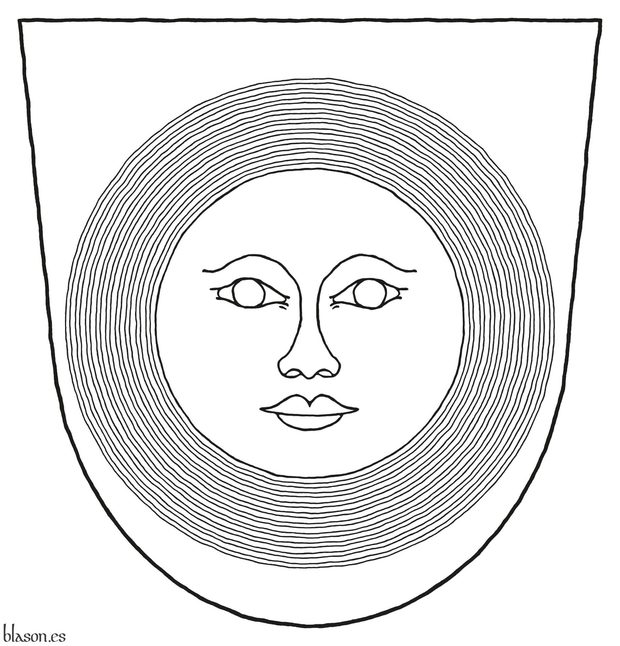
Azure, a moon with human face environed by nine concentric annulets Argent.
The coat of arms of María Asunción de León González designed by Juan Lanzagorta Vallín and myself outlined by me.
Blazon keywords: Azure, Argent, One, Nine, Moon, With human face, Environed, Concentric and Annulet.
Style keywords: Outlined, Outlined in sable and Rounded trapezoid.
Classification: Personal, Created, Boa and Coat of arms.
Bearer: María Asunción de León González.


María Asunción de León González, plain tincture
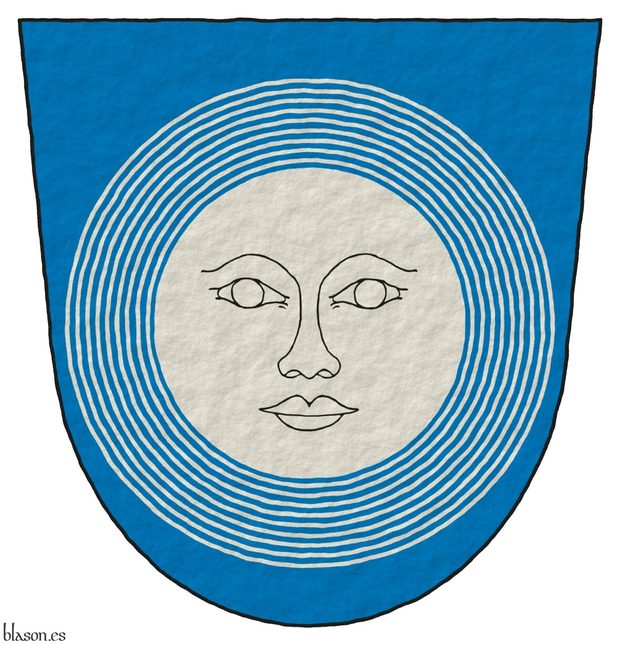
Azure, a moon with human face environed by nine concentric annulets Argent.
Coat of arms designed by me, in flat tinctures, outlined in Sable, with a rounded trapezoidal external shape and with a texturized finishing.
The coat of arms of María Asunción de León González designed by Juan Lanzagorta Vallín and myself emblazoned by me.
Blazon keywords: Azure, Argent, One, Nine, Moon, With human face, Environed, Concentric and Annulet.
Style keywords: Outlined in sable, Plain tincture and Rounded trapezoid.
Classification: Personal, Created, Boa and Coat of arms.
Bearer: María Asunción de León González.


María Asunción de León González
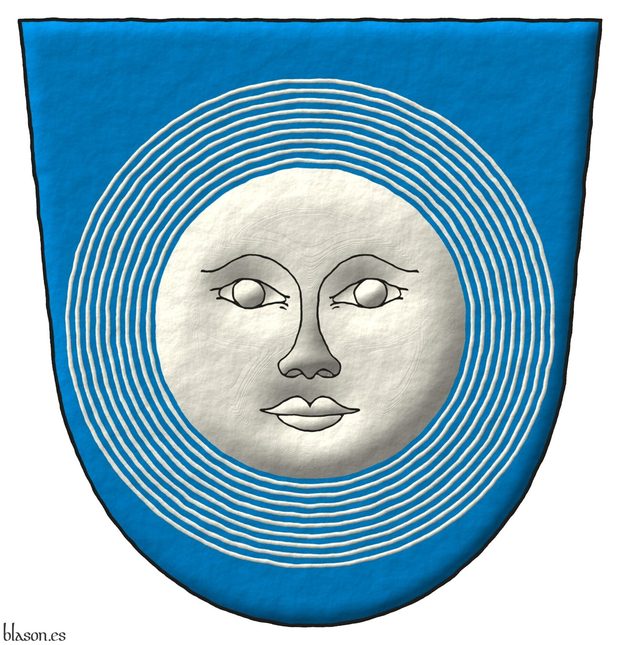
Azure, a moon with human face environed by nine concentric annulets Argent.
Escudo de azur, una luna figurada circundada de nueve anilletes concéntricos, todo de plata.
Arms designed by me, highlighted with lights and shadows, outlined in Sable, with a rounded trapezoidal external shape and with a freehand finishing.
Blazon keywords: Azure, Argent, One, Nine, Moon, With human face, Environed, Concentric and Annulet.
Style keywords: Outlined in sable, Illuminated, Rounded trapezoid and Freehand.
Classification: Personal, Created, Boa and Coat of arms.
Bearer: María Asunción de León González.


Bend-fess, demi-bend-fess, and fess-demi-bend
[Gules, a bend-fess Or], [Azure, a demi-bend-fess Or], and [Sable, a fess-demi-bend Or]
[Escudo de gules, una banda-faja de oro], [Escudo de azur, una semibanda-faja de oro] y [Escudo de sable, una faja-semibanda de oro]
The image shows three shields ending in an ogee arch and painted in plain tinctures.
I place «demi» at the beginning to signify that the first portion of the ordinary remains while the terminal portion is omitted; conversely, I place «demi» at the end to signify that the final portion is present while the initial portion is absent.
Categories: Bend-fess, Demi-bend-fess and Fess-demi-bend.


Demi-pale-fess, pale-demi-fess, fess-demi-pale, and demi-fess-pale
[Gules, a demi-pale-fess Argent], [Azure, a pale-demi-fess Argent], [Vert, a demi-fess-pale Argent], and [Sable, a fess-demi-pale Argent]
[Escudo de gules, un semipalo-faja de plata], [Escudo de azur, un palo-semifaja de plata], [Escudo de sinople, una semifaja-palo de plata] y [Escudo de sable, una faja-semipalo de plata]
The image shows four shields ending in an ogee arch and painted in plain tinctures.
I place «demi» at the beginning to signify that the first portion of the ordinary remains while the terminal portion is omitted; conversely, I place «demi» at the end to signify that the final portion is present while the initial portion is absent. In this way, a «demi-fess-pale» indicates that on the dexter side appears the dexter half of the fess, that is, its beginning, then follows the complete pale, and, finally, nothing continues beyond that point: the fess does not resume.
Categories: Demi-pale-fess, Pale-demi-fess, Fess-demi-pale and Demi-fess-pale.


Gorges, Ralph de
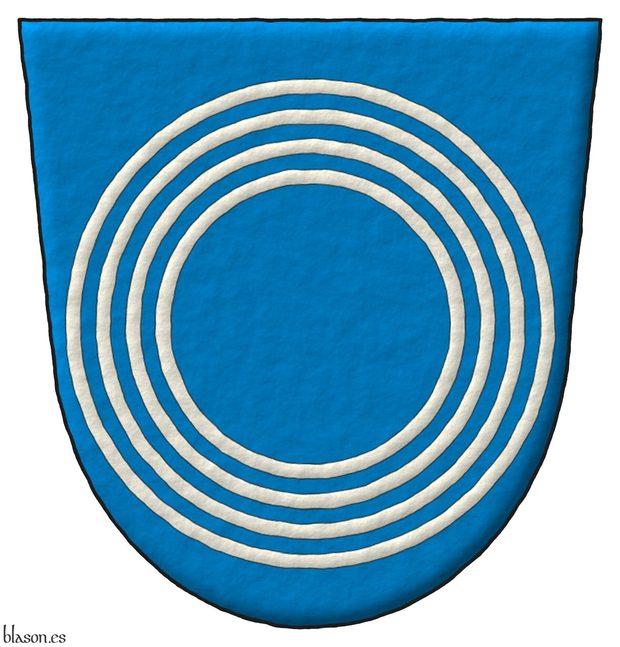
Azure, four concentric annulets Argent.
Escudo de azur, cuatro anilletes concéntricos de plata.
Coat of arms depicted by me, highlighted with lights and shadows, outlined in Sable, with a rounded trapezoidal external shape and with a freehand finishing.
The coat of arms of Ralph de Gorges emblazoned by me.
Blazon keywords: Azure, Argent, Four, Moon, With human face, Environed, Concentric and Annulet.
Style keywords: Outlined in sable, Illuminated, Rounded trapezoid and Freehand.
Classification: Personal, Interpreted, Boa and Coat of arms.
Bearer: Gorges, Ralph de.

Continue with: Hunzinger, Moritz.
-
Language
-
Categories of heraldry
-
Divisions of the field
- Without divisions
- Party per pale
- Party per fess
- Party per bend
- Party per bend sinister
- Tierce
- Tierce sinister
- Tierced per pale
- Tierced per fess
- Tierced per bend
- Tierced pallwise inverted
- Quarterly
- Quarterly per saltire
- Gyronny
- Party per fess, the chief per pale
- Party per pale, the sinister per fess
- Party per fess, the base per pale
- Party per pale, the dexter per fess
- Chapé
- Chaussé
- Embrassé
- Contre-embrassé
- Party per chevron
- Enté
- Enté en point
- Flanched
-
Metals
-
Colours
-
Furs
-
Other tinctures
-
Ordinaries and sub-ordinaries
-
Diminutives of the ordinaries
-
Geometric charges
-
Composite ordinaries
-
Inanimate charges from Nature
Atom, Crescent, Diamond, Emerald, Estoile, Increscent, Lightning flash, Moon, Mount, Mullet, Mullet of four points, Orbital, Plough of Ursa Major, Rainbow, Ray of the sun, River, Sea, Snowflake, Sun, Sun in splendour, Sun of May, Trimount and Water.
-
Vegetal charges from Nature
Acorn, Apple, Apple tree, Ash, Bluebonnet, Camellia, Chrysanthemum, Cinquefoil, Cornflower, Dogwood flower, Double rose, Elm, Fleur de lis, Flower, Gourd, Holm oak, Hop cone, Kapok tree, Laurel, Lily, Linden, Lotus flower, Madonna lily, Oak, Olive tree, Palm tree, Pomegranate, Poplar leaf, Rose, Shamrock, Sunflower, Thistle, Tree, Tulip, Vine and Wheat.
-
Animal charges from Nature
Badger, Bald eagle, Barbel, Barn owl, Bear, Beaver, Beetle, Bighorn sheep, Blackbird, Boar, Brach hound, Bull, Doe, Dog, Dolphin, Dove, Eagle, Elephant, Falcon, Fish, Flame, Fly, Fox, Frog, Goat, Goldfinch, Goose, Heron, Horse, Hummingbird, Jaguar, Lark, Leopard, Lion, Lion passant, Lion rampant guardant, Lioness, Lynx, Male figure, Martlet, Merino ram, Owl, Panther, Parrot, Peacock, Pelican, Pelican in her piety, Puffin, Quetzal, Raven, Roe deer, Rooster, Savage, Seagull, Serpent, She-wolf, Stag, Starling, Talbot, Tyger, Vulture, Warren hound and Wolf.
-
Parts of natural charges
Arm, Beak, Branch, Caboshed, Chest, Claw, Covert, Dorsal fin, Eagle claw, Ermine spot, Escallop, Feather, Foot (palmiped), Foreleg, Forepaw, Hand, Head, Heart, Hoof, Leaf, Neck, Ostrich feather, Palm frond, Paw, Roe deers' attires, Shoulder, Sprig, Stags' attires, Stem, Swallow-tail, Tail, Tail addorsed, Tail fin, Talon, Tooth, Trunk, Trunk (elephant), Two hands clasped, Two wings in vol, Udder, Wheat spike, Wing and Wrist.
-
Artificial charges
Ace of spades, Anchor, Anvil, Arch, Arm vambraced, Armillary sphere, Arrow, Axe, Bell, Bell tower, Beret, Bonfire, Book, Bookmark, Bow, Bridge, Broken, Buckle, Cannon, Cannon dismounted, Cannon port, Canopy roof, Carbuncle, Castle, Celtic Trinity knot, Chain, Chess rooks, Church, Clarion, Clay pot, Closed book, Club, Comb, Compass rose, Conductor's baton, Cord, Covered cup, Crozier, Crucible, Cuffed, Cup, Cyclamor, Dagger, Double vajra, Drum, Ecclesiastical cap, Fanon, Federschwert, Fleam, Four crescents joined millsailwise, Galician granary, Garb, Gauntlet, Geometric solid, Grenade, Halberd, Hammer, Harp, Host, Hourglass, Key, Key ward, Knight, Knot, Lantern, Letter, Line, Loincloth, Menorah, Millrind, Millstone, Millwheel, Monstrance, Mortar, Mullet of six points pierced, Nail, Non-classic artifact, Norman ship, Number, Oar, Oil lamp, Open book, Page, Pair of scales, Parchment, Pestle, Piano, Pilgrim's staff, Plough share, Polish winged hussar, Port, Portcullis, Potent, Quill, Ribbon, Rosette of acanthus leaves, Sabre, Sackbut, Sail, Scroll, Scythe, Sheaf of tobacco, Ship, Skirt, Spear, Spear's head, Stairway, Star of David, Step, Sword, Symbol, Tetrahedron, Torch, Tower, Trident, Trumpet, Turret, Two-handed sword, Wagon-wheel, Water-bouget, Wheel, Winnowing fan and With a turret.
-
Immaterial charges
Angel, Archangel, Basilisk, Dragon, Dragon's head, Garuda, Golden fleece, Griffin, Heart enflamed, Mermaid, Our Lady of Mercy, Ouroboros, Paschal lamb, Pegasus, Phoenix, Sacred Heart of Jesus, Saint George, Sea-griffin, Trinity, Triton, Unicorn, Winged hand and Wyvern.
-
External elements
-
Heraldic creations
-
References
-
Formats
-
Keywords on this page
Collared, Between, Watercolor, Tierce, Point upwards, Annulet, Article, Tied, Azure, Bend-fess, Bend-fess, demi-bend-fess, and fess-demi-bend, Bibliography, Boa, Pilgrim's staff, Arm, Gourd, Environed, Concentric, Ogee, Created, Crescent, Four, Outlined, Outlined in sable, Demi-pale-fess, pale-demi-fess, fess-demi-pale, and demi-fess-pale, Dexter, Two, In bend sinister, In chief, In base, In saltire, Coat of arms, Mullet, Fess-demi-bend, Fess-demi-pale, With human face, Personal, Gorges, Ralph de, Gules, Illuminated, Interpreted, Moon, María Asunción de León González, Nine, Argent, Plain tincture, Rounded trapezoid, Freehand and One.

![Bend-fess, demi-bend-fess, and fess-demi-bend [Gules, a bend-fess Or], [Azure, a demi-bend-fess Or], and [Sable, a fess-demi-bend Or]](../escudo_armas/PiezaCompuesta.10.Banda-faja.Semibanda-faja.Faja-semibanda.Esquema.1x3.jpg)
![Demi-pale-fess, pale-demi-fess, fess-demi-pale, and demi-fess-pale [Gules, a demi-pale-fess Argent], [Azure, a pale-demi-fess Argent], [Vert, a demi-fess-pale Argent], and [Sable, a fess-demi-pale Argent]](../escudo_armas/PiezaCompuesta.11.Semipalo-faja.Palo-semifaja.Faja-semipalo.Semifaja-palo.Esquema.2x2.jpg)